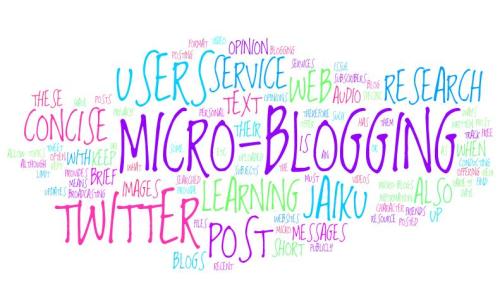
What is mircroblogging and how is it different than regular blogging:
As with traditional blogging, microbloggers post about topics ranging from the simple, such as “what I’m doing right now,” to the thematic, such as “sports cars.” Commercial microblogs also exist to promote websites, services and products, and to promote collaboration within an organization.
Some microblogging services offer features such as privacy settings, which allow users to control who can read their microblogs, or alternative ways of publishing entries besides the web-based interface. These may include text messaging, instant messaging, E-mail, digital audio or digital video.
The biggest difference is the “mirco” in microblogging – you have a limited amount of characters you can use in order to post your blog. For example, Twitter allows you 140 characters per post.
Microblogging offers a portable communication mode that feels organic and spontaneous to many and has captured the public imagination. Friends use it to keep in touch, business associates use it to coordinate meetings or share useful resources, and celebrities and politicians (or their publicists) microblog about concert dates, lectures, book releases, or tour schedules.
Types of microblogging sites:
- Twitter – The key player in microblogging
- Pownce
- Tumblr
- Jaiku – Twitters closest competitor
- MySay – Users actually say how they are feeling
- Hictu – Video microbloggers
- Moodmill – Express your mood or current state of being
- Frazr – Closer to Twitter but primarily German and French markets
- IRateMyDay – You rate your day from “Worst” to “Great” along with text
- Emotionr – Gauge your happiness on a scale of 1-10
For more information on these sites, check out Readwrite
Mircroblogging and Digital Marketing:
The Social Media Hat has great information on this subject.
First, business owners can use a microblog to quickly share short pieces of information with clients. These might include tips, links, news updates or video commentaries.
Due to the vary nature of a microblog, individual posts are generated quickly, giving businesses another way to post content to their site and share information with their customers, without having to devote as much time as a regular blog post might require.
Because posts can be easy and quick to accomplish, businesses can quickly generate a lot of actual website content and information in a microblog.
Businesses can also use microblogging internally. According to the Harvard Business Review, micoblogging can enhance productivity by allowing employees to rapidly exchange information and drive solutions which would otherwise take much longer — and be far more expensive to achieve.
In addition to providing customers with a nice, steady stream of information, businesses who utilize a microblog on their site will also be generating great content which will help with their search engine optimization (SEO), marketing (SEM) and ranking.
Microblog posts can be automatically or manually directed to social media platforms, depending on the nature of the microblog. A good marketer might also use microblog posts to fuel ongoing social media posts.
Microblogging is a great way to spread word about your company. You can post pictures of your employees in action, events, and products. You can post events and offer discounts to fellow users. Microblogging is a great way to put your business out there.